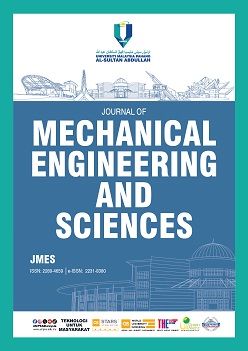Structural optimization of 2-dimensional steel truss beams with different truss members using finite element analysis
DOI:
https://doi.org/10.15282/jmes.18.4.2024.11.0817Keywords:
Steel truss, Optimization, Finite element analysis, Sustainable designAbstract
Trusses have long been integral to structural design due to their efficiency in bearing loads. However, a lack of clear guidelines for optimizing truss beams often forces engineers to compromise between performance and cost. This study addresses this gap by optimizing the shape and size of two-dimensional steel truss beams using Finite Element Analysis (FEA) with ABAQUS software under specified conditions. The analysis considered uniform vertical loads of 200 kN, 500 kN, and 200 kN applied at strategic joints, with pinned supports as boundary conditions. Four truss configurations; V-structure, V-structure with vertical members, N-structure, and K-structure were examined for stress, displacement, and critical buckling. The K-structure emerged as the optimal design, with the smallest deflection of -12.28 mm and a maximum stress of 178.85 MPa. Further, the High Edge A (HEA) 240 steel section was identified as the best cross-sectional choice, offering superior structural stability and cost-efficiency. This study demonstrates that strategic optimization of truss configurations and materials can significantly enhance performance while minimizing material use and costs. These findings have implications for safer and more economical steel truss designs, contributing to advancements in modern construction practices.
References
[1] T. H. G. Megson. Structural and Stress Analysis. 4th Eds. Amsterdam, Netherlands: Elsevier, 2019.
[2] B. C. Punmia, A. K. Jain. Strength of Materials and Mechanics of Structures. 11th Eds. Delhi, India: Laxmi Publications, 2003.
[3] S. K. Duggal. Limit State Design of Steel Structures. 2nd Eds. New Delhi, India: McGraw Hill Education, 2014.
[4] M. H. Faber, “Structural optimization,” Structural Safety, vol. 12, no. 3–4, pp. 237–255, 1993.
[5] A. O. Aghavere, J. Vigil. Structural Steel Design. 2nd Eds. London, United Kingdom: Pearson, 2015.
[6] E. G. Ahmad, “A review study on uses of steel in construction,” Latest Research in Science and Technology, vol. 5, no. 3, pp. 37–39, 2016.
[7] N. Chockalingam, M. Nithyadharan, V. Pandurangan, “Shear stress distribution in tapered I-beams: Analytical expression and finite element validation,” Thin-Walled Structures, vol. 157, p. 107152, 2020.
[8] J. J. Connor, S. Faraji. Fundamentals of Structural Engineering. 2nd Eds. London: Springer, 2016.
[9] W. T. Segui. Steel Design. 6th Eds. Stamford, CT: Cengage Learning, 2018.
[10] J. M. Ozimboski, Z. M. C. Pravia, M. Kripka, “Optimization of reinforced concrete beams and steel beams: A comparative study,” International Journal of Structural Glass and Advanced Materials Research, vol. 4, no. 1, pp. 160–167, 2020.
[11] L. Gil, A. Andreu, “Shape and cross-section optimisation of a truss structure,” Computers & Structures, vol. 79, no. 7, pp. 681–689, 2001.
[12] EN 1993-1-1:2005(E), “Eurocode 3: Design of Steel Structures - Part 1-1: General Rules and Rules for Buildings, European Committee for Standardization, 2005.
[13] M. Johansson, T. Löfberg, “Modelling of pitched truss beam with finite element method: Considering response of second-order effects and imperfections,” Master Thesis, Chalmers University of Technology, 2011.
[14] B. Davison, G. W. Owens. Steel Designers' Manual. 7th Eds. Oxford, United Kingdom: Blackwell Publishing Ltd., 2012.
[15] S. Mustafa, M. Z. A. M. Zahid, H. A. Yahya, “Optimum plane trusses among different cross sections,” International Transaction Journal of Engineering, Management, & Applied Sciences & Technologies, vol. 6, no. 5, pp. 45–58, 2015.
[16] P. S. K. Reddy, C. Nagaraju, “Structural optimization of different truss members using finite element analysis for minimum weight,” International Journal of Mechanical and Production Engineering Research and Development, vol. 9, no. 4, pp. 99–110, 2019.
[17] A. Jurčíková, M. Rosmanit, “FEM model of joint consisting RHS and HEA profiles,” Procedia Engineering, vol. 40, pp. 183–188, 2012.
[18] S. Sedmak, U. Tatic, B. Djordjevic, E. Dzindo, “Numerical calculation of a steel support structure for a pipeline using finite element method,” in 32nd Danubia Adria Symposium Advances in Experimental Mechanics, Stary Smokovec, Slovakia, pp. 213–217, 2015.
[19] N. Fanaie, S. S. Faegh, F. Partovi, “An improved and innovative formulation for calculating amplified elastic story drift induced by RBS connections in steel moment frames,” Journal of Constructional Steel Research, vol. 160, pp. 510-527, 2019.
[20] R. P. Vila, N. Lopes, L. S. da Silva, J. M. Franssen, “Parametric analysis of the lateral–torsional buckling resistance of steel beams in case of fire,” Fire Safety Journal, vol. 42, no. 6-7, pp. 416-424, 2007.
[21] J. M. Gere, S. P. Timoshenko. Mechanics of Materials. 4th Eds. Boston, MA: PWS Publishing Company, 1997.
[22] C. G. Salmon, J. E. Johnson. Steel Structures: Design and Behavior. 4th Eds. New York, United States: Harper Collins, 1996.
[23] Y. Q. Wang, Z. Q. Liu, B. Luo, “Structural performance of the improved CFRP-steel tube composite truss: A finite element analysis,” Arabian Journal for Science and Engineering, vol. 48, pp. 5637–5654, 2023.
[24] R. C. Hibbeler. Structural Analysis. 10th Eds. New Jersey, United States: Pearson, 2017.
[25] M. Nurhaniza, M. K. A. Ariffin, A. Ali, F. Mustapha, A. W. Noraini, “Finite element analysis of composites materials for aerospace applications,” in IOP Conference Series: Materials Science and Engineering, vol. 11, no. 1, p. 012010, 2010.
Downloads
Published
Issue
Section
License
Copyright (c) 2024 The Author(s)

This work is licensed under a Creative Commons Attribution-NonCommercial 4.0 International License.






